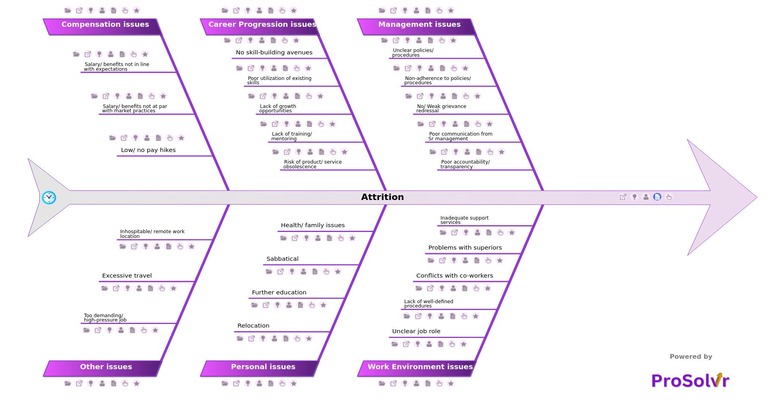Root Cause Analysis of Attrition
Employee attrition is a big worry for many companies. It brings higher costs for hiring new staff, losing skilled workers, and messing up work schedules. A major reason for high attrition is the lack of chances to grow in one's career. People want to advance and learn more, but if they can't do that in their current job, they'll start looking elsewhere.
Another reason for people leaving their jobs is the bad balance between work and personal life. In today's busy world, employees want time for their personal lives too. When companies don't offer flexible schedules or have too many demands, it leads to stress and unhappiness, and workers start thinking about quitting.
Not paying employees enough or offering good benefits also drives them away. Competitive salaries, good perks, and rewards for good work are vital for keeping top talent. When employees feel they're not getting what they deserve, they start job-hunting for better-paying options.
Moreover, a negative work culture adds to attrition rates. When there's no honesty, bad communication, or weak leadership, it makes employees feel unwanted. Building a supportive and open work culture where everyone feels valued and heard is crucial for reducing attrition and keeping workers happy and productive.
In conclusion, employee attrition can stem from a variety of factors spanning management issues, work environment challenges, career progression concerns, personal circumstances, compensation grievances, and other miscellaneous issues. Addressing these root causes requires a multifaceted approach, including improving management practices, fostering a supportive work environment, providing ample opportunities for career advancement and skill development, accommodating personal needs when possible, ensuring fair compensation and benefits, and mitigating other stressors that may contribute to turnover. By addressing these factors comprehensively, organizations can work towards reducing attrition rates and cultivating a more engaged and satisfied workforce.
Who should use the Attrition template?
- Human Resources (HR) Departments: HR professionals can utilize this template to analyze and understand the underlying causes of employee attrition within their organization. It can help them identify trends, prioritize areas for improvement, and develop targeted strategies to reduce turnover.
- Managers and Team Leaders: Managers and team leaders can use this template to assess the factors contributing to attrition within their teams. By understanding the specific challenges faced by their employees, they can implement changes to improve work conditions, communication, and career development opportunities.
- Organizational Development Specialists: Those responsible for organizational development can utilize this template to conduct comprehensive assessments of employee turnover across different departments or business units. This information can inform broader organizational strategies aimed at enhancing employee engagement and retention.
- Recruitment and Talent Acquisition Teams: Professionals involved in recruitment can benefit from understanding the factors driving attrition, as this knowledge can help them refine their hiring strategies to attract candidates who are more likely to stay with the organization long-term.
- Senior Leadership: Executives and senior leaders can use insights from the attrition template to make informed decisions about resource allocation, strategic priorities, and initiatives aimed at improving employee satisfaction and retention rates.
Overall, the attrition template serves as a valuable tool for anyone involved in managing, leading, or overseeing human capital within an organization, helping them identify and address the root causes of employee turnover effectively.
Why use the Attrition template?
- Identification of Trends: The template allows organizations to identify patterns and trends related to employee turnover. By categorizing the reasons for attrition, organizations can pinpoint common issues and address them more effectively.
- Targeted Solutions: With a clear understanding of the factors contributing to attrition, organizations can develop targeted solutions to address specific challenges. This can range from implementing new policies and procedures to improving communication or providing additional training and support.
- Resource Allocation: By prioritizing areas for improvement based on the insights gained from the template, organizations can allocate resources more effectively. This ensures that efforts are focused on addressing the most significant drivers of attrition, maximizing the impact of interventions.
- Retention Strategies: Armed with insights into the causes of attrition, organizations can develop comprehensive retention strategies. These strategies may include initiatives to enhance career development opportunities, improve work-life balance, or revise compensation and benefits packages to better meet employees' needs.
- Enhanced Employee Engagement: Addressing the root causes of attrition can lead to increased employee engagement and satisfaction. When employees feel valued and supported, they are more likely to remain with the organization and contribute positively to its success.
The attrition template serves as a valuable tool for organizations seeking to reduce turnover, improve employee retention, and create a more positive and productive work environment.
Draft and create a template for problem analysis in ProSolvr by smartQED.
Curated from community experience and public sources:








